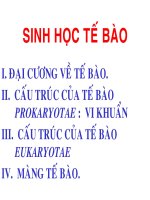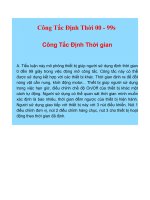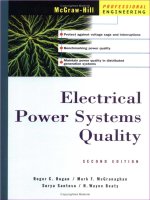C1083 00
Bạn đang xem bản rút gọn của tài liệu. Xem và tải ngay bản đầy đủ của tài liệu tại đây (12.21 KB, 2 trang )
Designation: C 1083 – 00
Standard Test Method for
Water Absorption of Cellular Elastomeric Gaskets and
Sealing Materials1
This standard is issued under the fixed designation C 1083; the number immediately following the designation indicates the year of
original adoption or, in the case of revision, the year of last revision. A number in parentheses indicates the year of last reapproval. A
superscript epsilon (e) indicates an editorial change since the last revision or reapproval.
5. Apparatus
5.1 Vessel, of potable water of dimensions appropriate to
permit proper submergence of the specimens as described in
Section 9.
5.2 Stand and Clamps, to hold specimens.
5.3 Balance, triple-beam, accurate to 0.01 g.
5.4 Paper, lint-free blotting.
1. Scope
1.1 This test method covers those cellular elastomeric compounds that are manufactured in preformed shapes such as
gaskets, and that are used as compression seals for glazing
purposes and as sealing materials in other applications in
building construction.
1.2 This standard does not purport to address all of the
safety concerns, if any, associated with its use. It is the
responsibility of the user of this standard to establish appropriate safety and health practices and determine the applicability of regulatory limitations prior to use.
1.3 The values stated in SI units are to be regarded as the
standard. The values given in parentheses are provided for
information purposes only.
6. Comparison to Other Standards
6.1 The ASTM Committee with jurisdiction over this standard1 is not aware of any comparable standards published by
other organizations.
7. Sampling and Test Specimens
7.1 Sampling:
7.1.1 When possible, the manufactured product or a suitable
section thereof shall be used for the test. Representative
samples of the lot being examined shall be selected at random.
7.1.2 When the manufactured product does not lend itself to
testing or to the taking of test specimens because of complicated shape, small size, metal or fabric inserts, or other reasons,
standard test strips shall be prepared. The standard specimens
for testing shall be as specified in 7.2.2.
7.1.3 The manufacturer shall, upon the request of the
purchaser at the time of ordering, furnish sufficient test
specimens prepared in accordance with Practice D 3182.
7.2 Test Specimens:
7.2.1 The test specimen shall be 460 mm (18 in.) long.
7.2.2 Test specimens that are to be prepared as described by
7.1.2 shall be 460 mm (18 in.) long, 13 mm (1⁄2 in.) thick, and
25 mm (1 in.) wide.
7.2.3 All test specimens shall be made from the same
compound and shall have the same apparent density and state
of cure as the product they represent.
7.2.4 This test method requires ten test specimens.
2. Referenced Documents
2.1 ASTM Standards:
C 717 Terminology of Building Seals and Sealants2
D 3182 Practice for Rubber—Materials, Equipment, and
Procedures for Mixing Standard Compounds and Preparing Standard Vulcanized Sheets3
3. Terminology
3.1 Definitions—Refer to Terminology C 717 for the following terms used in this test method: cell, compound,
compression gasket, elastomer, elastomeric, gasket, glazing,
seal, and sealing material.
3.2 Definitions of Terms Specific to This Standard:
3.2.1 cellular elastomer, n—in building construction, a
cured elastomeric material containing cells or small voids.
4. Significance and Use
4.1 This test method will quantify the water absorption
characteristics of cellular elastomeric gaskets and sealing
materials. It is a test that enables the specifier to exercise
engineering judgment in the selection of materials.
8. Conditioning
8.1 Condition all test specimens at 21.1 6 1.1°C (70 6 2°F)
for at least 24 h prior to testing.
1
This test method is under the jurisdiction of ASTM Committee C-24 on
Building Seals and Sealants and is the direct responsibility of Subcommittee C24.73
on Compression Seal and Lock-Strip Gaskets.
Current edition approved Jan. 10, 2000. Published March 2000. Originally
published as C 1083 – 87. Last previous edition C 1083 – 91 (1995).
2
Annual Book of ASTM Standards, Vol 04.07.
3
Annual Book of ASTM Standards, Vol 09.01.
9. Procedure
9.1 Identify each test specimen and individually weigh and
record the information.
Copyright © ASTM, 100 Barr Harbor Drive, West Conshohocken, PA 19428-2959, United States.
1
C 1083
11. Precision and Bias 4
11.1 The precision and bias calculations for this test method
are based on the results of four laboratories testing six
materials.
11.2 The between-laboratory accuracy of this test method in
the determination of water absorption (based on an average
over four laboratories) is 0.78 for the six test materials
evaluated. This means that if the absolute value of the
difference between two values is greater than 0.78, then 95 %
of the time this represents a statistical difference.
11.3 Limited information is available on the precision of
this test method. Only one sample of each material has been
tested in four laboratories using this test method. Past experience has shown that the within-laboratory precision of this test
method is expected to be less than the between-laboratory
accuracy.
9.2 Secure the test specimens in a vertical position using
stands and clamps. Clamp at both ends of each specimen so
that the specimens are bent in a U-shape.
9.3 Submerge only the center 406 mm (16 in.) of the test
specimens with the bottom of the loop 152 mm (6 in.) below
the water line, and the cut ends of the specimen out of the
water.
9.4 Test specimens shall be submerged in potable water at
23.9 6 1.1°C (75 6 2°F) for a period of 24 h.
9.5 Remove the test specimens from the water and blot with
lint-free paper before weighing. The blotting should be done
with as little pressure as possible so that only the surface water
is removed from the specimen.
9.6 Weigh each test specimen and record the values.
10. Report
10.1 Report the following information:
10.1.1 Identification of each test specimen.
10.1.2 Average weight of test specimens before testing.
10.1.3 Average weight of test specimens after testing.
10.1.4 Average weight of water absorbed by the test specimens.
10.1.5 Variation, if any, from the specified test procedure.
12. Keywords
12.1 absorption; cellular; elastomeric; gaskets; glazing;
sealing materials; water
4
Supporting data are available from ASTM Headquarters. Request RR:
C24 – 1083.
The American Society for Testing and Materials takes no position respecting the validity of any patent rights asserted in connection
with any item mentioned in this standard. Users of this standard are expressly advised that determination of the validity of any such
patent rights, and the risk of infringement of such rights, are entirely their own responsibility.
This standard is subject to revision at any time by the responsible technical committee and must be reviewed every five years and
if not revised, either reapproved or withdrawn. Your comments are invited either for revision of this standard or for additional standards
and should be addressed to ASTM Headquarters. Your comments will receive careful consideration at a meeting of the responsible
technical committee, which you may attend. If you feel that your comments have not received a fair hearing you should make your
views known to the ASTM Committee on Standards, at the address shown below.
This standard is copyrighted by ASTM, 100 Barr Harbor Drive, PO Box C700, West Conshohocken, PA 19428-2959, United States.
Individual reprints (single or multiple copies) of this standard may be obtained by contacting ASTM at the above address or at
610-832-9585 (phone), 610-832-9555 (fax), or (e-mail); or through the ASTM website (www.astm.org).
2









